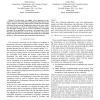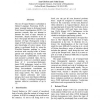22 search results - page 1 / 5 » Semi-supervised Clustering for Word Instances and Its Effect... |
CICLING
2009
Springer
14 years 10 months ago
2009
Springer
We propose a supervised word sense disambiguation (WSD) system that uses features obtained from clustering results of word instances. Our approach is novel in that we employ semi-s...
IRCDL
2007
13 years 10 months ago
2007
Abstract— In this paper we suggest a new approach to represent text document collections, integrating background knowledge to improve clustering effectiveness. Background knowled...
ICCS
2007
Springer
14 years 3 months ago
2007
Springer
In this paper, we propose an automatic text classification method based on word sense disambiguation. We use “hood” algorithm to remove the word ambiguity so that each word is ...
COLING
2008
13 years 11 months ago
2008
The use of topical features is abundant in Natural Language Processing (NLP), a major example being in dictionary-based Word Sense Disambiguation (WSD). Yet previous research does...
LREC
2008
13 years 10 months ago
2008
Word Sense Disambiguation (WSD) is an intermediate task that serves as a means to an end defined by the application in which it is to be used. However, different applications have...


